Sometimes I think I need some medicine to cure greed. The more of it the better. Because when I first started growing violets from seeds, I (stupidly) decided that the survival rate won’t be good, and sowed another packet of seeds… Oh, what a huge mistake!
Second seeds experiment
The previous batch of seedlings looked like they were slowly dying, so I adjusted the process with the new seeds.
- Sown on 18th of November 2017 in a deli container with a lid.
- Growing medium: equal parts of perlite, vermiculite and broken Jiffy Pellet.
- Growing conditions: LED light, nice temperature (approx 20-22C).
- They all started germinating on day 10 and I ended up with 137 seedlings.
- I noticed the first flower bud on 15th of March, 4 months after sowing. That plant flowered a month later, at 5 months after germination.
They were visibly growing and changing every day, and quickly outgrew the older batch of seedlings. I started replanting them on 26rd of January 2018, two months after germination. Every repotting gave them a growing boost, so I had to repot them every 5-6 weeks – first into shared containers, next into individual pots where they were supposed to stay until the first flowering cycle.
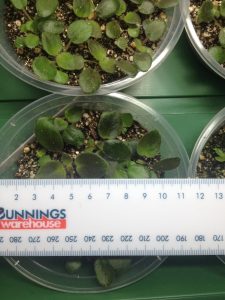
Winter has come
Winter effectively ruined my plans for the fast selection of the plants for the future hybridization work – the colder it was, the less they developed and flowered. By mid-winter almost all my seedlings hybernated – they didn’t rot or die, but they didn’t grow either. Some nights the temperature indoors was as low as 9-12 degrees Celsius.
The seedlings I had on watering mats suffered from water damage from condensate on leaves. For a few weeks my morning routine included drying my seedlings with paper towels, and I had to put them all on wick watering instead of mats – less water evaporated, less water ended up on the leaves as condensate at night.
Tough decisions
I was never able to discard of a perfectly healthy plant before I started this particular batch of seeds. I was so sure that it is my duty to give them all a chance, find them a good home, keep them. But hundreds of seedlings in individual pots were a great reality check – one day I woke up and understood that I simply shouldn’t keep more plants that I can care for.
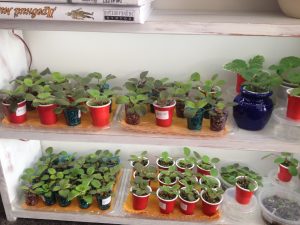
It was really hard to discard of plants before they flowered – what if there are some jewels there – but somehow I managed. I composted big seedlings (because I was after miniatures), light-sensitive seedlings that didn’t like my LED lights, seedlings with poor symmetry. Every time I felt tired of watering all that plants, I went through my trays and simply discarded everything that I didn’t like. My reasoning was – if I don’t like it now, what are the chances I’ll like it later? Will a good flower outweigh this particular foliage? If ‘no’ was the answer, to the compost bin it went.
I re-homed a few dozens of miniature and trailer seedlings, but mostly I learned to discard. By the first of December 2018 (a year after sowing) I had 44 plants left from this batch and kept discarding as soon as they flowered as blue or magenta pansy dropper.
How did my 137 violet seedlings bloom
As of December 2018, I still wait for some of them to flower for the first time. But here are a few numbers:
- One seedling is longifolia. It is boring blue pansy dropper, but I kept it for its foliage.
- 35 out of 137 were discarded before flowering – because of their size and overall form of the plant.
- Only four plants in this batch have non-dropper semi-double flowers. One of these plants is mini, one – semi, two reached standard size even in 5cm pots.
- 20 were blue pansies, none of them truly small plants.
- 8 were magenta pansies, all semi-miniatures.
- 6 were stars of different colours.
- Some were bells.
- Several had fantasy markings, but none were truly interesting or unique.
- Two plants were variegated, and both are either semi-mini or small standards, time will tell.
I will finalize the numbers once all of them flowered.
The biggest disappointment
A surprisingly large number of plants in this batch are not really miniatures or semi-miniatures. They are so vigorous they reach standard size even in 5.5 cm pots. So every time just another biggish plant opens its first bloom, I have to tell myself ‘I’d keep it as a mini, but I don’t need it as a small standard or big semi-miniature’.
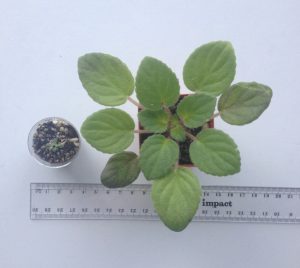
I can not really blame my growing conditions – I’ve heard that miniatures tend to grow bigger on wick watering with a good fertilizer. But if a plant has got 4X5 cm leaf blades, there’s no way it is a miniature, no matter how I feed it.
I had a particular group of 13 plants that were very promising – small, with different types of foliage, with great form and symmetry. In the Spring, when the average temperature increased, all these plants started growing bigger and bigger and all but one are now in semi-mini – small standard size range.
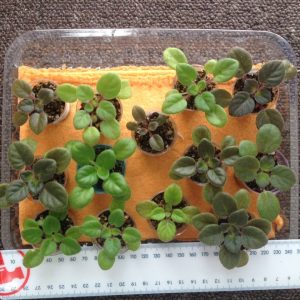
Overall impression
This batch of violet seedlings was large enough to understand what are average mini Nadeau violets grown from seed.
- Most have single dropper flowers.
- Most have great form and symmetry.
- They have different types of foliage of all shades of green.
- There was a particular group of plants that were light-sensitive and got bleached after a day on a shelf under LED lights where all other violets feel great. All light-sensitive plants had the same looking thin leaves, so I assume they can be from the same cross.
- Most are vigorous and not fussy.
- Majority have low flower count – 1-2 flowers per stalk at the first blooming cycle. Some improved and had 3-4 flowers per stalk in the next cycle, some didn’t improve.
- Majority have weak long bloom stalks – really hard to get rid of in your future hybridizing.
- A few are miniatures, most are semi-miniatures or standards.
- They are very fertile and start seed pods easily when pollinated – which makes them good ‘mothers’ for my projects.
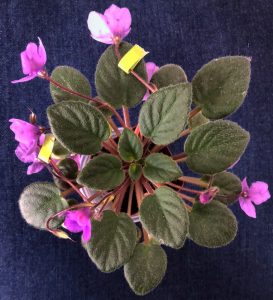
Lessons learned
- Don’t sow all seeds at once if you don’t have enough space to grow them all.
- Throwing away healthy plants is a pain. When I did it the first time, I hovered over the trash bin for a couple of days, trying hard not to dig the plants out. After 8 months of throwing plants, it is still the pain. Minus hovering over the trash. It became easier when I started composting unwanted seedlings instead of throwing them into the garbage. The peat-based mix I use is a good soil conditioner, and discarded violets go into the ‘circle of life’.
- Seedlings take lots of limited resources: space, time, growing mix, water, fertilizer. Being ruthless when selecting plants to keep is a must. Learning to be ruthless is also pain.
- Having a goal helps with the selection process. I am after miniature violets, so I focused on small plants and didn’t spend time waiting for blooms on bigger seedlings.
- The opportunity to grow from someone else’s seeds with unknown parentage is a great learning experience. It wasn’t my cross, so I didn’t feel that plants were too ‘precious’ to get rid of. I am quite sure if I started with seeds from my own cross, I’d keep much more plants just because ‘they are my babies’. I hardened my heart with these seedlings, and now ready to cross and grow my own seeds without going into ‘motherly’ mode.
- Growing African violets from seeds is a skill. And like any skill, it can be learned. This batch of seedlings was my ‘growing from seeds’ class – and for that I am grateful. I learned how to handle tiny plants, I was brave enough to repot them, I developed a watering system that works for me, I tested all types of small plastic cups and containers as pots and water reservoirs and found some cost-effective options, I tested 6 versions of growing mix. After a year of doing all that I feel much more confident that I can grow violets from seeds with a good survival rate.
- It is important to have a repotting schedule. With miniature seedlings in small pots and tiny shot glasses, it is crucial to repot after 4-6 months. I totally missed it and was reluctant to repot before the plants bloomed. My reasoning was ‘why spend time and mix now, let’s wait for the flowers and repot only the ones I want to keep’. Well, you know what? They didn’t bloom anyway, and some developed highly deformed crowns after 8-10 months in the same 60 ml container. So I had to repot all plants anyway, and they revived after that and now are starting to bloom. Unfortunately, it’ll take a few months for that deformed crowns to develop new healthy foliage. I wish I prevented that by repotting on time.
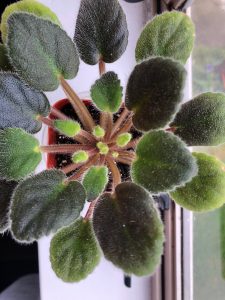

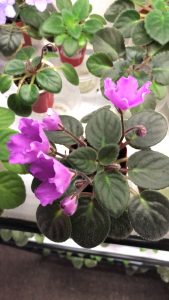
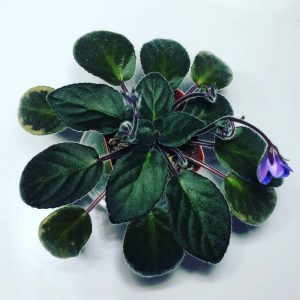
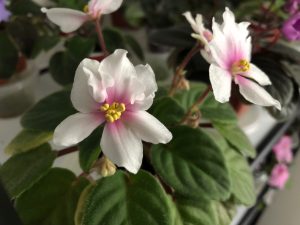

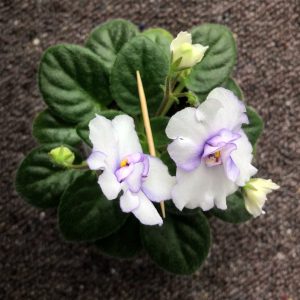


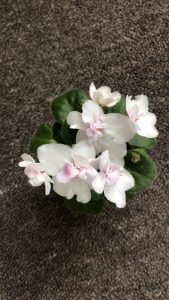

3 Comments.
Excellent feedback. Can identify with everything said..
Interesting read. Thanks for sharing your experiences.
Thank you! Good information, good writing, most enjoyable. I also grew Nadeau seeds when I read that they were selected for fertility. I figured this would give me good experience growing and crossing violets. It did. I let all of my Nadeau seedling bloom and took pictures of each of them. My germination rate was much less than yours. You can see them at: https://frondlyyours.blogspot.com/2017/09/nadeau-african-violet-seedlings.html